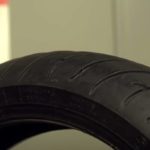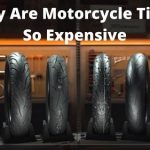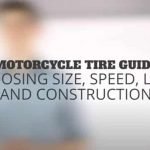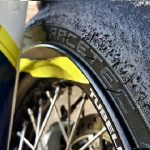A common question that we get from first-time motorcycle buyers is why a motorcycle tire is so expensive?
Three main components contribute to the higher tire price compared to a car or SUV tire. Motorcycle tires have more engineering requirements than car tires, as there are significant differences in high power-to-weight ratio, size of contact footprint, and other elements.
Engineering requirements increase the cost of a motorcycle tire. Tire design and engineering are perhaps the most important steps in a motorcycle tires production process.
Electronic schematics, field tests, and extensive testing must ensure that each tire holds the necessary safety and quality standards.
Motorcycle tires are made from several materials that require considerable time and effort to source, contributing to the tires’ overall cost.
Natural rubber is obtained from a rubber tree’s latex and is then combined with petroleum-based synthetic rubbers.
Other costing ingredients are added to perfect the properties of the rubber compound.
The cost of materials influences the final retail cost of your motorcycle tires.
Finally, the production process requirements can contribute to the final retail price of motorcycle tires.
Assembly curing and, crucial quality control testings are labor-intensive parts of the production process.
Workers will check each tire shape and measurement for any defects and run it through a computerized road simulation that spins the tire at average road speeds.
What Types Of Tires Are Available?
We all know that the tires on your bike are critical to performance and safety, but there are many options out there to choose from.
To help you make sense of things, I’m going to describe the five main tire categories and driving the point home; I’m going to compare them to shoes.
Tires are always a compromise between grip and durability. They range from hard, long-lasting buns for touring bikes, all the way up to super soft, super grippy race slicks.
Which tires are best for you depends on the kind of bike you ride, what type of road you ride on, your style of riding and how long you have been riding, and, of course, weather conditions.
So keep all of that in mind as I describe these five tire categories. To kick things off, we’re going to start with the category of tire I like to compare to work boots.
Cruiser Tires
All the Harley’s, Indian’s, victories, and customs you see out on the road, are going to be rolling around on a tire like the popular Bridgestone tires.
Bridgestone’s Exedra Max is sick and stiff because it’s designed for extremely heavy, really big motorcycles.
Think of them as work boots, sturdy and durable and made for doing work.
Cruiser tires are meant to handle a lot of miles and perform well in all weather conditions, so they use a harder rubber compound, as well as lots of tread grooves to channel out water.
They’re great for straight-line stability and offer awesome mileage, but not necessarily a lot of performance or outright grip, and on a cruiser, that’s an ideal compromise.
On the spectrum of street tires, cruiser rubber is at one end to mark the boundaries. Let’s move to the other end of the spectrum and talk about slicks.
Slick Tires
Slicks are thick. I have raced on VStone VO2’s, and let me tell you, and there is nothing as inspiring as the first heat cycle on a fresh pair of slick. The grip is just unbelievable.
These things are the pinnacle of performance, and because of that, they are very expensive, and it has very specific criteria that need to be met for them to offer optimal grip.
They’re very sensitive to pressure and temperature, and because they grip so incredibly well, they only last about two dozen laps. In the world of shoes, slicks are sprinter spikes.
They are very focused, totally uncompromising, and totally out of place at any place but the track.
I’ve heard Street riders say if they think they need flex because they’re headed to the track, but that’s kind of like a casual jogger strapping these bad boys on to go for a run around the park.
It is total overkill and, frankly, it’s totally unsuitable unless you can meet the requirements of the equipment for slicks.
That means using tire warmers to heat them to about 180 degrees and washing your pressures like a hawk.
DOT Race Tires
Just below race slicks are DOT race tires. These are essentially slick with a minimum amount of tread cut in them to meet Department of Transportation standards and conform to production racing rules.
They might look like street tires, but there are totally different animals.
Like slicks, DOT tires need to be hot, to grip well, only work well in the dry, only offer optimal traction for a heat cycle or two and are constructed specifically for racing.
That means a stiffer carcass for handling vicious acceleration and braking and an aggressive profile with a tall crown.
DOT race tires with the Bridgestone R10’s are kind of like top-end running shoes in terms of footwear.
We’re talking about the kind of kicks that athletes put on to click off a five-minute mile.
They are awesome for performance, definitely made for speed, but not exactly ideal for everyday walking.
As for using your racer buddies, DOT takes off on the street because you want to be the fastest guy at Mulholland, don’t Do it.
There is no way you’re going to get these things hot enough to work. These are race use only, which is why you can only get them through trackside vendors.
Sports Touring Tires
This next category of tires combines a little bit of that Cruiser tire durability with a lot of performance.
Sport touring tires like the T30 is like cross-trainers or trail running shoes. They are comfortable, they are versatile, and they are very athletic.
These are the shoes I like to wear daily, and ST tires are what I want to be riding on.
In this category of the tire, you’re likely to see many tread groups. Some of which are going to extend towards the middle of the tire to help with water dispersion.
However, the shoulders might be slick or semi-slicks, si you have a great grip at full lean.
Some sport touring tires like the T30S are dual compound. They have a harder rubber down the middle for mileage, so you don’t wear the thing out while you’re commuting or touring, and then there’s softer rubber on the shoulders so you can still slay it in the corners.
The compound is also designed to work across a wide range of temperatures, and there’s stuff, like silica mixed into the rubber, so there’s good wet grip.
That means ST tires will work well, whether it’s cold and rainy or hot and dry.
In terms of traction, sport-touring tires have more than enough to drag me, and they’re going to last a long time.
I know, when you think of SP rubber, you think of old guys on BMWs, but modern sport-touring tires, they’re badass.
They offer lots of performance regardless of the weather or the temperature, and they’re going to last a long time.
Hypersport Tires
Last but not least is a category of tires that I liken to a good pair of jogging shoes or running shoes.
As the name suggests, Hypersport tires are all about performance. They’re made to rip it up on a twisty road and also do the occasional track day.
Tires like the RS10, the R stands for racing, and the S stands for the street.
They utilize a ton of trickle-down race tire technology to offer you more traction, speed, and agility.
The RS10 even looks like the DOT race tires, but they’ve got a few more tread grooves to tune the tire’s behavior.
These are the tires that come stock on Honda’s CBR-1000RRSP, the GSXR-1000, and the YZFR1. They are definitely at the premium end of the street tire spectrum.
Hybrid sport tires are also a little more sensitive to temperature and pressure than sport-touring tires, and they’re not always great in the wet.
They do often use a dual compound tread to give you a little bit better mileage, but the fact is they tend to wear out quickly. But hey, that’s the price you pay for a great grip.
In my opinion, RS10’s are the type of tires you put on your sportbike if you’re submitted to riding only twisty roads or track days.
Unfortunately, a lot of street riders think they need Hypersport tires because they ride hard.
The truth is they’d probably be better off on sport touring tires. You’re going to get more versatility with an ST tire and more life out of it.
And there you have it. My out-of-sequence take on the five main street bike tire categories.
I hope you guys learn something about the many tire choices that are out there.
Relates Tire Articles
- 2 Reasons Why A Motorcycle’s Rear Tire Wear on One Side?
 Tires and tire pressure are like oil; everybody has an opinion and will fight to defend it. So why does the outside of the rear tire wear down on the side?
Tires and tire pressure are like oil; everybody has an opinion and will fight to defend it. So why does the outside of the rear tire wear down on the side? - Should You Replace Motorcycle Tires In Pairs? (Mythe Busted)
 Motorcycle tires are among the topics and discussions usually reserved for politics and religion. That makes sense because you have to think about replacing tires from time to time, but
Motorcycle tires are among the topics and discussions usually reserved for politics and religion. That makes sense because you have to think about replacing tires from time to time, but - 3 Reasons Why Motorcycle Tires so Expensive
 A common question that we get from first-time motorcycle buyers is why a motorcycle tire is so expensive? Three main components contribute to the higher tire price compared to a
A common question that we get from first-time motorcycle buyers is why a motorcycle tire is so expensive? Three main components contribute to the higher tire price compared to a - What Size Motorcycle Tire Do I Need & Why
 Today we’re looking at how to choose the size, the speed, the load, and the construction of the tire for your bike. We will also look at what specifications you
Today we’re looking at how to choose the size, the speed, the load, and the construction of the tire for your bike. We will also look at what specifications you - When To Change Motorcycle Tires – Myth vs. Fact
 How do you know when to change motorcycle tires? Stick around we’re gonna go over some of the telltale signs that your tires are worn out with our detailed video guide on when to change motorcycle tires.
How do you know when to change motorcycle tires? Stick around we’re gonna go over some of the telltale signs that your tires are worn out with our detailed video guide on when to change motorcycle tires.
Previous Article: Why A Motorcycle’s Rear Tire Wear on One Side?
Next Article: Should You Replace Motorcycle Tires In Pairs?


